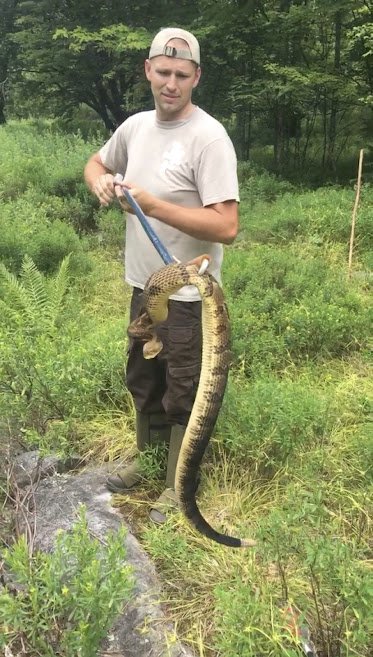If you have watched the news any in the last few years, it’s no doubt that you have heard this phrase uttered with the iconic yellow flag depicting a rattlesnake striking. Although the flag has questionable origins, it’s believed to have been created around the time of the Revolutionary War, but there is little to question in its symbolism.
West Virginia only has two species of venomous snakes. Copperhead (Agkistrodon contortrix) and the Timber Rattlesnake (Crotalus Horridus).
The rattlesnake was chosen because of the threat that it imposed to any enemy that might wish to bring harm upon it. That legendary symbol can be found in almost all parts of our home state.
West Virginia only has two species of venomous snakes. Copperhead (Agkistrodon contortrix) and the Timber Rattlesnake (Crotalus Horridus). The Scientific name for the Timber Rattler is derived from Latin and is translated as Crotalum, meaning “rattle” and Horridus for “dreadful.” These snakes definitely demand caution, however, their reputation as purely evil reptiles has become grossly exaggerated. As a matter of fact, only 4 people have died of Timber Rattlesnake bites since 1969 in West Virginia. In comparison and on average, every year 20 people are killed by Cows in the US.
Rattlesnakes can be found throughout WV, but the habitat with the highest density of snakes tends to be mountainous rugged terrain.
Rattlesnakes can be found throughout WV, but the habitat with the highest density of snakes tends to be mountainous rugged terrain. Areas that have a large amount of rocks and open canopies to allow the sunlight that is needed to regulate their body temperature. Most rattlesnake dens contain 30 to 60 snakes. This is their home and they rarely stray too far from it. Recent studies showed that Timber Rattlesnakes travel 1 to 2.5 miles from their den.
This time of year, the snakes begin to make their way back to the dens so that they can give birth.
During the summer and early fall tends to be when most Rattlesnakes are observed. If it’s a particularly dry summer, such as we are having, the snakes will move down the mountain in search of water from nearby streams and creeks. This time of year, the snakes begin to make their way back to the dens so that they can give birth. On average, they will birth 9 live baby rattlesnakes.
In my profession, I hear many stories. I’ve had people tell me they were chased by Timber Rattlers and explain to me how aggressive that the snakes were upon their interaction. Simply put, this is not true. Rattlesnakes want nothing to do with humans. Their first defense is their camouflage. Timber Rattlers can range from dull brown and black to a brilliant yellow phase.
If it eats well, it will shed a couple times or more a year and each fresh shed will add another rattle.
The color pattern varies from snake to snake and color can not be used to determine if it is male or female. If the first defense doesn’t work, they will use their rattle to warn off any potential danger to them. The rattle is nothing more than an adapted scale at the end of the tail that snaps together, almost like the tracks for Hot Wheels cars. The number of rattles does not indicate the snake’s age.
If it eats well, it will shed a couple times or more a year and each fresh shed will add another rattle. On the opposing end, these rattles can be ripped off going under rocks or by predators. Lastly, if the other two defenses fail to protect the snake, it will bite and could potentially inject venom into its aggressor. The venom of a Rattlesnake is simply an adapted saliva that is scientifically known as a hemotoxin. This means that it acts to destroy tissue. The bite will cause the area to swell, turn black and as you can imagine, its extremely painful and potentially deadly. If you are bitten, seek medical attention immediately.
In closing, Timber Rattlesnakes are on a decline in West Virginia.
In closing, Timber Rattlesnakes are on a decline in West Virginia. Their numbers are dropping every year and this is due to things such as decline in habitat and predation. West Virginia did permit a person to possess one Timber Rattler if it was a minimum of 42 inches in length. This year, that law has changed. No person in West Virginia shall possess a Timber Rattlesnake. These are truly amazing reptiles that simply want to be left alone. If you have never seen a live one, take a trip to the West Virginia State Wildlife Center located in French Creek or The Cranberry Mountain Nature Center in Hillsboro and check out their displays.
– Dustin Allen, HashtagWV #135. September 2021.
HashtagWV Art & Entertainment is a high-quality print and digital multimedia platform for all things West Virginia and the greater Appalachian region. The editorial focus is local music, unique shopping, the arts, events, theatre, and food and drinks. tiktok.com/@hashtagwv
-
HashtagWVhttps://hashtagwv.com/author/hashtagwv/
-
HashtagWVhttps://hashtagwv.com/author/hashtagwv/
-
HashtagWVhttps://hashtagwv.com/author/hashtagwv/
-
HashtagWVhttps://hashtagwv.com/author/hashtagwv/





